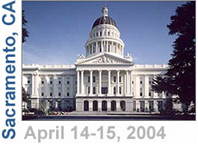Natural Gas Vehicle Technology Forum 2004 Meeting Summary

A Natural Gas Vehicle Technology Forum (NGVTF) Technical Committee Meeting was held April 14-15, 2004, in Sacramento, California.
Meeting Summary
One purpose of this NGVTF Technical Committee Meeting was to highlight California's natural gas vehicle (NGV) and infrastructure activities. Presentations from California government agencies and industry groups provided updates on policy, projects, and market conditions affecting the state's NGV efforts. Other presentations covered NGV and infrastructure technology development and marketing, small scale liquefied natural gas (LNG) production, and codes & standards. Many attendees also toured Pacific Gas & Electric's experimental small scale LNG production facility, which is located nearby. Panel discussions and networking opportunities facilitated crucial discussions among stakeholders and helped shape plans for furthering NGV technologies.
To request a specific presentation from this meeting, contact NGVTF.
More than 80 representatives of industry, government, research institutions, and nonprofit organizations attended the meeting. The meeting coordinators collected written comments from attendees and are using this feedback to plan future NGVTF meetings. The comments indicated that the following aspects of the meeting were particularly useful:
- Networking events, including the reception and lunches
- Updates on government activities
- Small scale LNG liquefaction information
- Open discussions and panel discussions
- Technical updates
- PG&E liquefier tour.
The comments also indicated that the following topics are of interest for future NGVTF meetings:
- More feedback from customers and end users
- More technical presentations from manufacturers
- Success stories and case studies
- Details on natural gas spark ignition systems and emission controls
- Strategizing what actions to take to lead the promotion of NGVs.
The following additional themes emerged from discussions at the meeting:
How Clean Will Diesel Be, and How Cheap?
One of the most important questions is, what will the environmental and economic bottom lines of diesel and natural gas be in the future?
Needed: A New NGV Spin
Because of their decreasing emission advantage over conventionally fueled vehicles, NGVs must be promoted based on other factors:
- Energy security—closing the petroleum gap
- Greenhouse gas emission reductions
Challenging Times for Vehicle Availability
Ford is getting out of alternative fuels. Most OEMs feel that small AFV sales don't justify continued efforts. New standards are likely to reduce availability of aftermarket conversions after 2005.
Encouraging Signs in California
Schwarzenegger/Tamminen have aggressive environmental policies for California. Recent reports emphasize the importance of closing the petroleum gap in California in the next few decades.
Beware of Hydrogen Hype
It is good to show the role of natural gas in the transition to hydrogen, but this shouldn't distract from focusing today on a proven alternative fuel (natural gas) instead of an unproven one (hydrogen).
Working Together
The NGV industry must work together to makes its voice heard in a unified manner by government, customers, and investors.
Creative Funding
Government NGV funding is limited, but private funding opportunities exist. Investors must be shown there is a potential return.
NGVs are Mature, but Technical and Market Challenges Continue
The challenges include lack of manufacturing integration, uncertainty in firmness of emission standards and government policies, and lack of qualified mechanics.
Meeting Customer Needs
To be competitive, the NGV industry must meet customer needs, including consistent service, diesel-like performance and convenience, adequate infrastructure, uncomplicated logistics, reliability, and longevity.
Potential New Infrastructure Paradigm on the Horizon
FuelMaker's home refueling appliance (Phill) could change the way people fill up, and could help lower the NGV infrastructure barrier.
Small-Scale LNG Sources: New Opportunities and Challenges
Small scale sources of LNG are being explored, including landfill gas, coal mine gas, small scale pipeline liquefaction, and stranded wells. Each has its own unique benefits and challenges to implementation. Still, the United States is likely to increase LNG imports in the future.
LNG Tank and Composition Standards Proposed
Standards provide consistent safety, reliability, and performance—but are difficult and contentious to create. Do we need new standards? The Clean Vehicle Education Foundation and Canadian Standards Association are working on new standards.
